An Entrepreneur’s Perspective.
Transformative Technology entrepreneurs are in a unique and powerful position to do tech and business from a different level of consciousness. Since every innovation and founding team is different, it’s important for founders to sense into what the most appropriate structures and fuel are for what wants to emerge. This topic is so important because setting up an entity and courting investors is basically choosing who to work for and what type of life to have. Join this session (recording coming soon) to learn about alternatives to VC funding and hear from a TT entrepreneur who has chosen a different path.
Disclaimer: The materials here are for informational purposes only and not for the purpose of providing legal advice. You should contact your attorney to obtain advice with respect to any particular question or challenge.

The genesis of this piece / presentation was a series of conversations with TT Co-Founder and Executive Director Nichol Bradford about different structures and approaches to startup creation that we were seeing in the wild. As a TT entrepreneur through my work with Siempo, I’m one of many in the community who has been reflecting on what time it is on Earth and holding a strong intention to show up with more integrity — to be on the right side of history, find all-win solutions and alignment across all aspects of my business, from fundraising to product development.
In preparing this, one theme kept surfacing, as it seems to be one of the great challenges of our time:
How can we bring more heart into a head-designed world?
If the predictions about this industry are accurate, then the way TT companies show up may serve as a model for how the next generation of startups are built. That’s an amazing opportunity and responsibility. So let’s drop into our hearts, experiment and share wisdom outwards.
Starting with Why
First, let’s take a step back and check in on what we’re doing here.
Fundamentally, what’s your why?Simon Sinek famously offered this “Start with Why” approach to clarifying a business’s reason for existing. Simon says: “People don’t buy WHAT you do; they buy WHY you do it.” Always begin with an inquiry here (vs. starting with WHAT your product is and then backing out a why) and return periodically to reconnect with the essence of the thing that you will move mountains for.
Ethically, consider if your startup should exist period and what potential consequences may arise (see: Omidyar Ethical OS, Humane Technology Worksheet). Investor and TT speaker Tim Chang argues:
“Tech isn’t good or bad, it’s just a tool. Therefore, what matters most is the intention or energy we wield it with. That’s what we should we be looking at now.
None of us, as investors or founders, have ever asked the question: ‘Yes this can make money. Should we? Should this exist? Is this good for people?’”
While you can never fully predict the impact of introducing a new agent into a system, you can go through the exercise of creating negative design personas and brainstorming how the product might generate negative externalities or be used for malevolent purposes, and then adjust your strategy accordingly.
Personally, are you ready to commit years of your life to this? If everything we create is an expression of who we are and what we value, all our fears and biases and traumas, are you at a place in your adult development to responsibly steward a new innovation and a team of humans? What can you and your team start doing today to progress on that path?
What are you? Choosing Corporate & Ownership Structures
Alright, now let’s get into the meat.
You and a couple of friends have an idea and decide to start hacking something together. First thing you do is obviously form a company (Delaware c-corp), right?
Maybe! Consider holding off on formalizing anything until there is more clarity on what is emerging and who is involved. Focus on building trust and coherence. Get creative about exchanging value before pulling out the paperwork. For the meticulous, Slicing Pie is an excellent tool to track contributions in the early days.
While startups typically incorporate as for-profit c-corporations, there has been a recent proliferation of non-profit tech companies. Many celebrated ventures are playing in the middle ground between the two, as Public Benefit Corporations (Kickstarter) and hybrid organizations (Mozilla), or alternative for-profit models like worker-owned co-ops or a Pentagram.
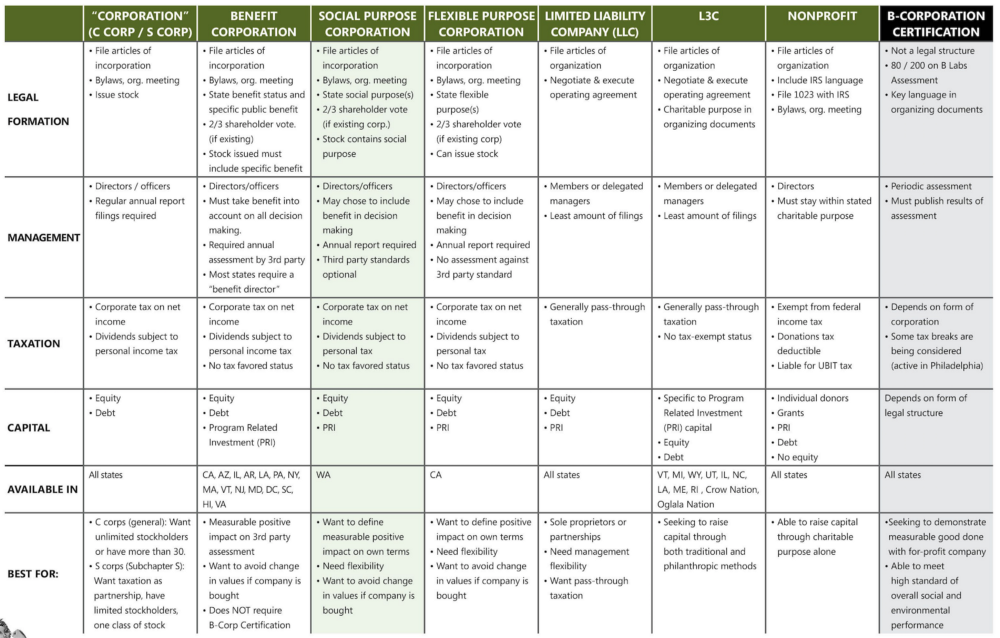
Source: SPC WA
This table breaks down the different entity types, and clarifies the difference between a B-Corp (certification) and Public Benefit Corporation (legal incorporation type). I want to double click on Public Benefit Corporation because I think it’s a great middle ground that has advantages for every stakeholder in your business, without closing doors to investment and growth opportunities.
It basically says “hey we exist to serve more than our shareholders and customers — we also exist for this stated public benefit and are going to measure success by how well we progress on that mission.” The PBC entity type provides legal protection to directors to balance financial and non-financial interests when making major decisions, and is attractive to impact investors, mission-driven talent and potential partnerships. It sends a signal. Examples include AltSchool, Kickstarter, Patagonia.
What do you need? Choosing a Boss and a Diet
Let’s switch gears to talk about fundraising.
According to the Kauffman Foundation, 81% of entrepreneurs do not access a bank loan or venture capital. In fact, venture capital accounts for less than 1% of all startup funding. In a startup culture that celebrates multi-million dollar funding milestones seemingly above all other success metrics, it’s no wonder that most founders assume a path of venture capital for their babies. However, the VC route may not be the right fit for all TT companies, and fortunately there are many compelling alternatives to explore.
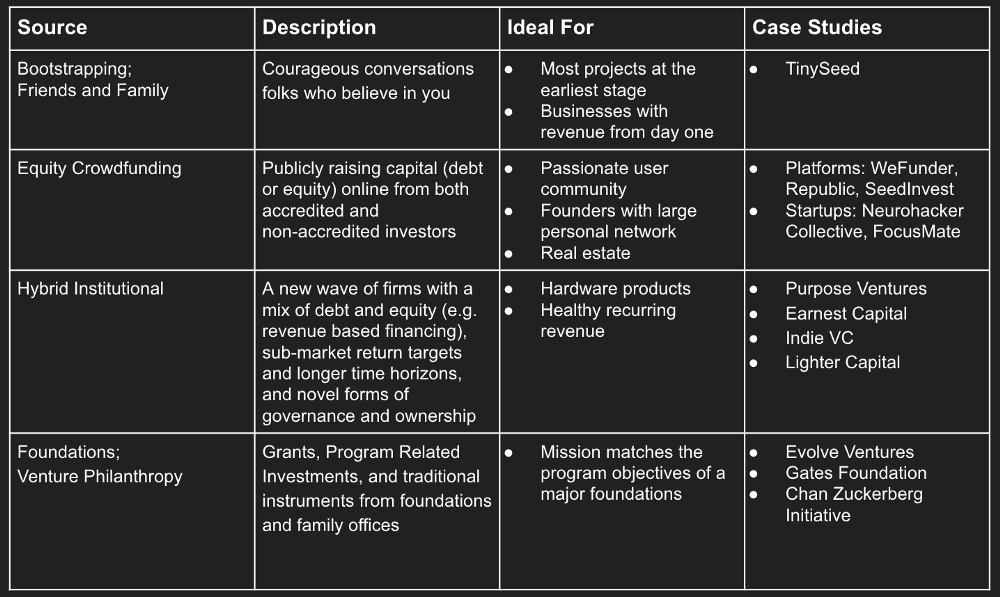
Note of caution: playing with alternative forms of fundraising may narrow your pool of available capital now and in the future. While impact investing is on the rise and there is a nascent community of “patient” investors open to sub-market returns, it’s still the early adopter phase of the trend, so supply is small and may not be available for your specific market niche. It’s also possible that later stage investors may not be thrilled about creative forms of early stage funding, in the example of equity crowdfunding.
What I do want you to take away here is the funding structure you choose is an operating system for a relationship that can last for many years. So know your options and choose wisely — don’t waste time on chasing venture if you’re not suitable for it. If venture is right for you, know what you’re getting yourself into.
Whenever you are thinking about taking money, consider the intention behind it. What are you signing up for? Where is it the capital coming from upstream? Who are the LPs and how are they leveraging their resources in the world? i.e you’re choosing a boss, so who do you want to make money for?
And on a mental health note, post round depression is a real thing. Don’t sign up for something that you don’t know if you can commit to, that your heart doesn’t truly desire. If you care about your wellbeing and the integrity of the mission, be discerning about how to bring that into the world. There’s an interesting tension between output and self-care for TT founders; what does it look like to embody this balance in personal and professional life?
How will you do it? Implementation Structures
Now that you’ve chosen your identity, why you’re doing it, who you want to work for and how you want to grow, a final major area to consider is how you want to organize people to make it happen!
Hire in-house, outsource or share contractors? Didn’t Zappos do something cool? How can you be an effective leader in this time of disruption?
Naturally, these choices will depend on who is at the table, what their needs are, and what gets prioritized at the earliest stages of growth. Most accelerators support entrepreneurs in finding product market fit and raising money, with organizational development as an afterthought. If the core of any business concerns how to cohere a bunch of people to do an important thing, then why aren’t we talking about how to do that better?
Fortunately some best practices and models are emerging for the empathetic and purpose-driven entrepreneurs out there. So much has been studied and written on this topic. I’m just going to call out a few frameworks and trends that I think are most relevant for this cohort.
First, let’s take a look at teal organizations. Inspired by Ken Wilbur’s Integral Theory, Frederic Laloux wrote a book called Reinventing Organizations in 2014 after years of academic research on companies around the globe. Laloux posits that as humans have evolved states of consciousness throughout history, they have developed organizational models to coincide.
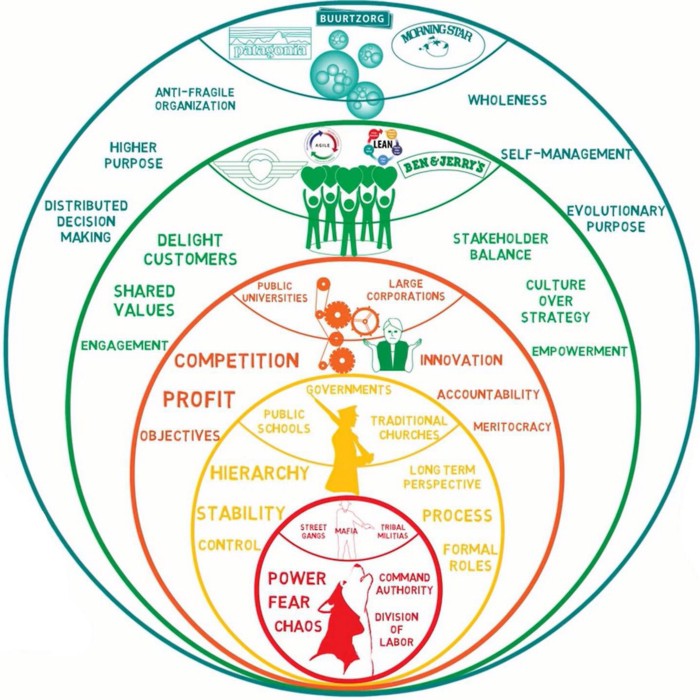
Source: SDK
Teal can be credited with bringing about certain fundamental breakthroughs in how humans collaborate: concepts like self-management, wholeness, evolutionary purpose, and organizations as living systems.
Practiced by over 1,000 organizations globally, holacracy replaces conventional management hierarchy with a concrete framework for encoding autonomy, agility, and purpose-alignment into your organization’s DNA. Holacracy is a part of the Teal movement focused on self-management.
In holacracy, positions, called “Roles”, are defined around the work, not people. Each person fills several roles according to one’s skills and talents. They may come from different circles (groups of roles) and are defined by name, purpose, accountabilities and few other elements. Decisiveness and authority among the company is distributed to roles so all decisions are made locally.
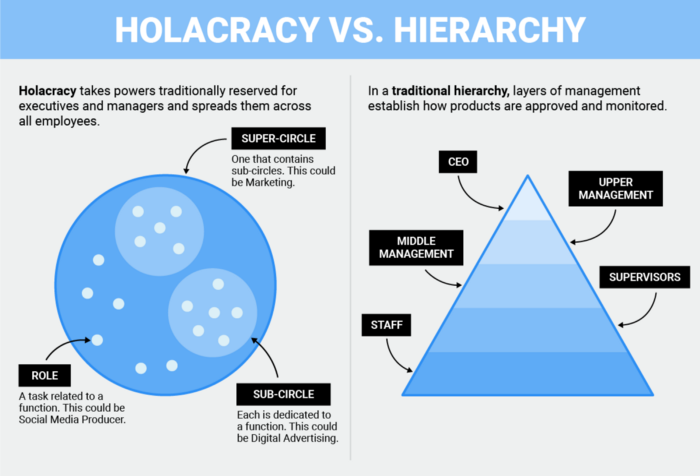
Source: Future Frontiers
If you aren’t thinking about diversity, inclusion and equity, then you’re shooting yourself in the foot. Isn’t it obvious by now that we are each a product of our life experiences and awarenesses, so teaming up with folks who aren’t like you would be advantageous to the organization, among countless other reasons? If nothing else, study after study shows how diverse teams outperform more homogenous teams.
On that note, Zebras Unite is less of a strategy and more of a new story or cultural trend, calling for a more ethical and inclusive movement to counter existing startup and venture capital culture. The Zebras community counts more than 4,000 values-driven entrepreneurs and investors and is a great source of wisdom around alternative structures.
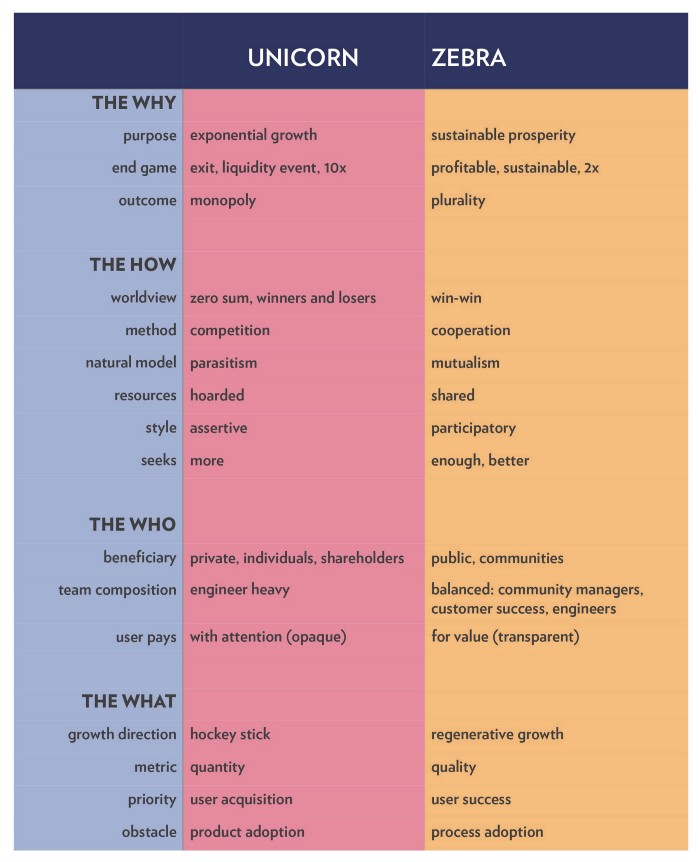
Source: Zebras Unite
“We believe that developing alternative business models to the startup status quo has become a central moral challenge of our time.
These alternative models will balance profit and purpose, champion democracy, and put a premium on sharing power and resources.
Companies that create a more just and responsible society will hear, help, and heal the customers and communities they serve.”
-Jennifer Brandel, Mara Zepeda, Astrid Scholz, Aniyia Williams
With fully female leadership, Zebras Unite has been outspoken about how feminine qualities have been subordinate to male qualities in our dominant business mythology and desperately needed to create a more beautiful and just world for all — in startup culture especially, which is emerging as one of our most influential institutions.
So whereas unicorn companies are marked by exponential growth and competition and zero sum, zebras are more about sustainable growth and collaboration and win-win scenarios.
In a similar vein, Sister.is is a feminist business school, proposing a new set of values and illustrations of what our economy might look like that if it were more balanced and didn’t predominantly value masculine traits.
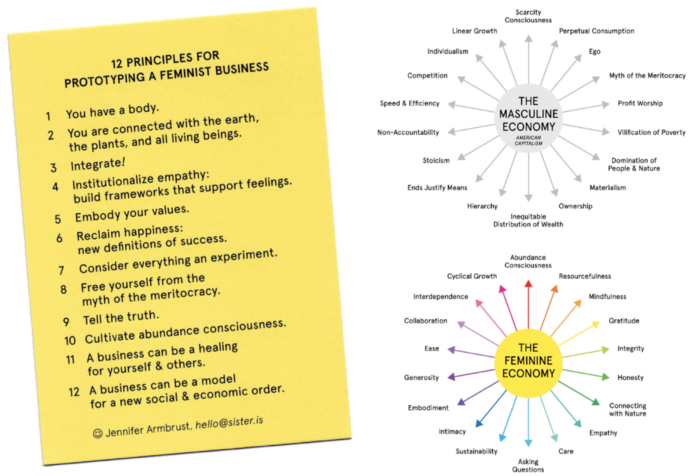
Source: Sister.is
It’s not that all of The Masculine Economy qualities are BAD. It’s that we haven’t leveraged the gifts as the feminine nearly as much, and so we have an imbalance in society which is contributing to lots of our systemic challenges. A key difference is many of these masculine-associated qualities are concerned with “doing”, while those of the feminine are related to being, allowing, opening, receiving. We need both! We need a balance.
I appreciate Zebras Unite and Sister for raising awareness of these imbalances and inviting us to bring more of the heart into the business world. To be self aware, adaptive, omni-considerate in decision making, and creating change in the world that is long term sustainable and regenerative.
At the end of the day, starting a business is extremely challenging, and sometimes it’s easier just to take the tried and true path. We haven’t even touched into alternative revenue models, governance models, compensation structures, go to market strategies.
As psychological support and growth industries garner more visibility, TT companies have a unique responsibility to model better corporate citizenship. The invitation is to do your research and experiment with the ingredients that are best aligned with what wants to emerge, but not to a point of uncompromising stubbornness. Take risks and spread the wisdom outwards for the benefit of the whole.
Philosopher Forrest Landry offers:
“The most effective choices are those which are optimal in supporting creativity and experience, wholeness and integrity.
An effective choice supports self and world — it allows the greatest freedom to be and to become, to choose and choose again.”
May you find the courage to make effective choices in this time of transition.

Andrew Murray Dunn is social entrepreneur focused on creating technology that protects and promotes human thriving.
He currently leads Oakland-based Siempo: the first smartphone interface designed to support mental health and wellbeing, and has worked in operations roles at early stage startups including Flexport




